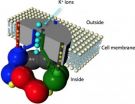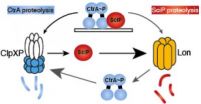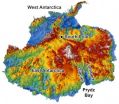(Press-News.org) Ann Arbor, Mich. — Each year, more than 130,000 children younger than 13 are treated in U.S. emergency departments after motor-vehicle crash-related injuries.
Each of these visits offer a chance to pass along tips for proper use of child passenger restraints, but a new study from the University of Michigan indicates emergency departments may not be taking advantage of those opportunities.
In the study published today in Pediatric Emergency Care, more than one-third of ER physicians say they are uncertain whether their departments provide information about child passenger safety resources to their parents, says lead author Michelle L. Macy, M.D., M.S., of the University of Michigan's C.S. Mott Children's Hospital.
Less than half of the physicians responding in this study said that a parent of a 2-year-old being discharged following a motor-vehicle crash would be provided with discharge instructions including advice about car seats.
"Unfortunately, our research showed that many emergency physicians are not aware of community resources for child passenger safety," says Macy, who is a clinical lecturer in the Department of Emergency Medicine.
"We know the visit to the emergency department is a crucial opportunity to prevent future injuries. Families are frequently discharged following a car crash without referrals to local resources where parents can obtain additional information about child safety seats. This is concerning because child safety seats are complicated, and serious misuses are common," says Macy.
Motor-vehicle collisions remain a leading cause of death among children younger than 4 years and the leading cause of death among older children in the United States, in part because child passengers continue to be unrestrained, and 20 percent of 1- to 3-year-olds and nearly half of 4- to 7-year-olds do not use the recommended restraint for their age.
Macy and her co-authors also found that children who are seen in general emergency departments (without pediatric specialization) are the least likely to receive car seat information. But these general emergency departments treat more than 85% of children who need emergency care.
"Fewer than 15 percent of children seeking emergency care in the U.S. are seen in an emergency department with specialized pediatric services, such as our ER at C.S. Mott Children's Hospital. So there's a huge number of physicians out there who may not have specialized pediatric resources available for their patients," Macy says.
According to the National Highway Transportation Safety Administration, child safety seats should be replaced following a car crash unless these conditions are met:
(1) the airbags did not deploy, (2) there was no vehicle intrusion nearest the safety seat, (3) the vehicle could be driven away from the collision, and (4) no passengers were injured.
Macy says she hopes this research will spur more emergency departments to begin providing resources to patients and connecting parents to existing community resources.
"It will be the kids that benefit, if their parents get the right information about how to use restraints and prevent injuries," says Macy.
C.S. Mott Children's Hospital is a proud champion of child passenger safety through our Mott Buckle Up Program. In 2012 our team checked over 2,500 car seats across our region and distributed nearly 600 car seats to low-income families.
INFORMATION:
For more information on scheduling a car seat check or to find a location nearest you, please call 734-763-2251 or visit: http://www.michigancarseats.com
Journal citation: Pediatr Emer Care 2013;29: 00Y00
Additional authors: All of the University of Michigan: Sarah J. Clark, M.P.H,; Rebecca M. Cunningham, M.D.'; and Gary L. Freed, M.D., M.P.H.
Funding: Grant from the Michigan Center for Advancing Safe Transportation throughout the Lifespan.
About C.S. Mott Children's Hospital in the University of Michigan Health System:
Since 1903, the University of Michigan has led the way in providing comprehensive, specialized health care for children. From leading-edge heart surgery that's performed in the womb to complete emergency care that's there when you need it, families from all over come to the University of Michigan C.S. Mott Children's Hospital for our pediatric expertise. In 2013, C.S. Mott Children's Hospital was ranked eighth in the nation in Parents Magazine's 10 Best Children's Hospitals ranking.
END
WASHINGTON, D.C. — Women's issues play a major role in the health of the nation and should be a key consideration for policymakers as they design and set up the new insurance exchanges, according to a report co-authored by policy experts at the George Washington University School of Public Health and Health Services (SPHHS). The report offers a checklist for the state-based health insurance exchanges, one that will help ensure that women, children and family members can get the services they need to prevent costly and debilitating medical problems.
"Women often use a ...
PHILADELPHIA - Omega-3 fatty acids found in oily fish may have diverse health-promoting effects, potentially protecting the immune, nervous, and cardiovascular systems.
But how the health effects of one such fatty acid -- docosahexaenoic acid (DHA) -- works remains unclear, in part because its molecular signaling pathways are only now being understood.
Toshinori Hoshi, PhD, professor of Physiology, at the Perelman School of Medicine, University of Pennsylvania, and colleagues showed, in two papers out this week in the Proceedings of the National Academy of Sciences, ...
BETHESDA, MD – March 5, 2013 -- A team of European scientists from the University Medical Center Hamburg-Eppendorf (UKE) and the Cologne Excellence Cluster on Cellular Stress Responses in Aging-Associated Diseases (CECAD) at the University of Cologne in Germany has taken an important step closer to understanding the root cause of age-related dementia. In research involving both worms and mice, they have found that age-related dementia is likely the result of a declining ability of neurons to dispose of unwanted aggregated proteins. As protein disposal becomes significantly ...
In Africa and Thailand, communities that worked together on HIV-prevention efforts saw not only a rise in HIV screening but a drop in new infections, according to a new study presented this week at the Conference on Retroviruses and Opportunistic Infections in Atlanta.
The U.S. National Institute of Mental Health's Project Accept — a trial conducted by the HIV Prevention Trials Network to test a combination of social, behavioral and structural HIV-prevention interventions — demonstrated that a series of community efforts was able to boost the number of people tested ...
Chevy Chase, MD—In a Position Statement unveiled today, The Endocrine Society advocates that all methods for measuring estrogens, which play a crucial role in human biology, be made traceable to a common standard.
In addition to the well-known role of estrogens in sexual development, these hormones, particularly estradiol, have a significant impact on the health of the skin, blood vessels, bones, muscle, kidney, liver, digestive system, brain, lung and pancreas. Studies have linked changes in estradiol levels to coronary artery disease, stroke and breast cancer.
"Estradiol ...
AMHERST, Mass. – Biochemists at the University of Massachusetts Amherst including assistant professor Peter Chien recently gained new insight into how protein synthesis and degradation help to regulate the delicate ballet of cell division. In particular, they reveal how two proteins shelter each other in "mutually assured cleanup" to insure that division goes smoothly and safely.
Cells must routinely dispose of leftover proteins with the aid of proteases that cut up and recycle used proteins. The problem for biochemists is that the same protein molecule can be toxic garbage ...
A new report published today concludes that nearly half of Africa's wild lion populations may decline to near extinction over the next 20-40 years without urgent conservation measures. The plight of many lion populations is so bleak, the report concludes that fencing them in - and fencing humans out - may be their only hope for survival.
Led by the University of Minnesota's Professor Craig Packer and co-authored by a large team of lion biologists, including Panthera's President, Dr. Luke Hunter, and Lion Program Director, Dr. Guy Balme, the report, entitled Conserving ...
In order to build and maintain cells, DNA is copied into ribonucleic acid (RNA) molecules, also called transcripts. Transcripts are often like a recipe for making proteins, and a collection of all the transcripts in a cell is called a transcriptome.
Pankaj Jaiswal, Assistant Professor of Botany and Plant Pathology at Oregon State University, Samuel Fox, a Postdoctoral Associate in Jaiswal's laboratory, and colleagues assembled transcriptomes of a noxious weed, Brachypodium sylvaticum, or slender false brome. The transcriptome provides an extensive genetic tool for studying ...
Antarctica's topography began changing from flat to fjord-filled starting about 34 million years ago, according to a new report from a University of Arizona-led team of geoscientists.
Knowing when Antarctica's topography started shifting from a flat landscape to one with glaciers, fjords and mountains is important for modeling how the Antarctic ice sheet affects global climate and sea-level rise.
Although radar surveys have revealed a rugged alpine landscape under Antarctica's two-mile-thick ice sheet, the surveys tell nothing about when the continent's deep valleys ...
Washington, D.C.—New theoretical modeling by Carnegie's Alan Boss provides clues to how the gas giant planets in our solar system—Jupiter and Saturn—might have formed and evolved. His work was published recently by the Astrophysical Journal.
New stars are surrounded by rotating gas disks during the early stages of their lives. Gas giant planets are thought to form in the presence of these disks.
Observations of young stars that still have these gas disks demonstrate that sun-like stars undergo periodic outbursts, lasting about 100 years, which transfer mass from the ...



